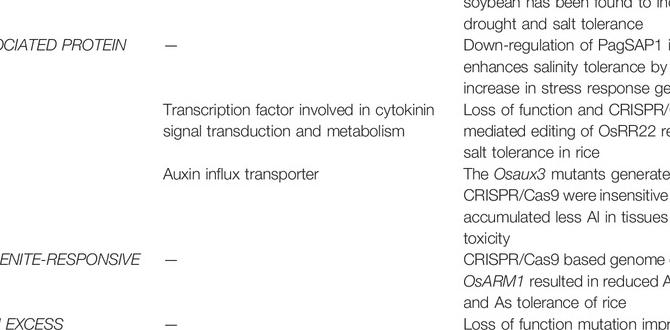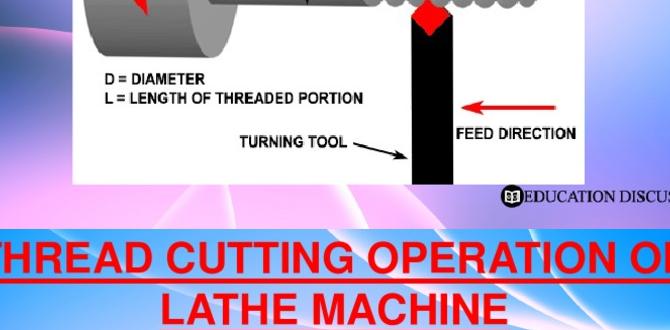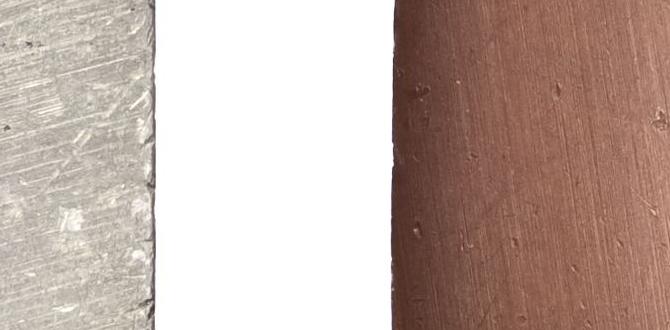A 1/8 inch carbide end mill with a 1/2 inch shank is a great choice for effective PVC chip evacuation when machining. Its precise cutting edges and appropriate flute design help prevent overheating and melting, leading to cleaner cuts and easier material removal in your projects.
Cutting PVC on your mill can sometimes feel like a battle against melting plastic. It’s a frustrating problem many beginners face when working with this popular material. Instead of a clean chip, you end up with a gummy mess that clogs your end mill and ruins your workpiece. This usually happens because the heat generated during cutting isn’t carried away effectively. Fortunately, selecting the right tool, like a specific type of 1/8 inch carbide end mill, can make all the difference. We’ll walk through exactly why this tool is a proven winner for PVC and how to use it to get those clean, manageable chips every time.
Why a 1/8 Inch Carbide End Mill is Perfect for PVC
When you’re facing down a piece of PVC on your milling machine, the material itself presents a unique challenge. PVC, or polyvinyl chloride, is a thermoplastic. This means it softens and melts when it gets hot. Standard cutting processes can quickly generate enough heat to make the PVC gum up around the cutting tool. This leads to poor surface finish, extra work to clean up, and can even damage your end mill. This is where the right end mill comes into play.
A 1/8 inch carbide end mill, especially one designed for good chip evacuation, hits a sweet spot. Let’s break down why:
- Carbide Material: Carbide is much harder and more heat-resistant than high-speed steel (HSS). This means it can withstand the higher temperatures generated when cutting PVC without softening as quickly. This toughness is crucial for maintaining sharp cutting edges.
- 1/8 Inch Diameter: This smaller diameter is ideal for intricate details and less aggressive cuts, which are often necessary when working with softer plastics like PVC. It allows for better control and generates smaller chips that are easier to evacuate. Smaller chips generally mean less heat buildup compared to large, stringy chips from a larger diameter cutter.
- Shank Size (1/2 Inch): While the cutting diameter is 1/8 inch, a 1/2 inch shank provides a robust connection to your milling machine’s collet or holder. This large shank offers rigidity, reducing chatter and vibration. This stability is key for achieving smooth cuts and preventing the cutter from bogging down, which can exacerbate melting issues.
- Flute Design for Evacuation: This is where the “proven PVC evacuation” comes into play. End mills designed for plastic or general machining often have specific flute geometries. For PVC, you’re looking for end mills with:
- Higher Helix Angles: A steeper helix angle (e.g., 30-45 degrees) helps lift chips out of the cutting zone more efficiently.
- Polished Flutes: Smooth, polished flutes reduce friction and give the melted or softened plastic less surface to stick to. This allows chips to flow out more freely.
- Fewer Flutes: Often, 2-flute end mills are preferred for plastics. The extra space between the flutes (gullet) provides a larger channel for chips to exit. More flutes can mean better surface finish on harder materials, but for softer plastics like PVC, efficient chip removal is paramount.
Understanding the “Chip Evacuation” Concept
Chip evacuation is a fancy term for getting the small pieces of material you’re cutting (the chips) away from the cutting tool and out of the workpiece as quickly as possible. For metals, this is about preventing chip recutting and tool breakage. For plastics like PVC, it’s about preventing melting and gummy buildup.
When machining PVC, the heat generated by friction needs to escape. If the chips stick to the end mill, they trap heat. This makes the PVC around the end mill even softer, causing it to stick more, creating a vicious cycle resulting in:
- Poor Surface Finish: Instead of a smooth cut, you get a melted, rough surface.
- Tool Loading: The end mill gets clogged, reducing its cutting efficiency and potentially leading to tool breakage.
- Material Distortion: Excessive heat can warp or deform the PVC part.
- Dimensional Inaccuracy: Melted plastic can fill in the cut areas, making your part undersized or misshapen.
A high-quality 1/8 inch carbide end mill with a design optimized for chip evacuation, often featuring a higher helix and polished flutes, actively helps in this process. The aggressive helix angle helps to “screw” the chips up and out of the cut, while polished flutes offer less resistance. This allows fresh air or coolant (if used) to get to the cutting edge, keeping it cooler.
Key Features to Look for in a 1/8 Inch Carbide End Mill for PVC
Not all 1/8 inch carbide end mills are created equal, especially when dealing with materials like PVC. When you’re shopping, keep these specific features in mind:
Material & Coating
- Solid Carbide: This is non-negotiable for PVC due to heat and hardness requirements.
- Uncoated or TiN (Titanium Nitride) Coating: For PVC, uncoated or a basic TiN coating is often sufficient and cost-effective. TiN provides a slight increase in hardness and lubricity, which can be beneficial. Avoid highly specialized coatings like AlTiN or TiAlN unless specifically recommended for plastics, as they are designed for much higher heat at extreme cutting speeds, which can sometimes lead to different issues with softer materials.
Geometry and Flutes
- 2-Flute Design: As mentioned, this provides excellent chip clearance, crucial for preventing melting.
- High Helix Angle (30° – 45°): This aggressive angle is key for efficiently lifting chips out of the cut and reducing chip recutting.
- Polished Flutes: Look for descriptions like “mirror finish” or “highly polished.” This significantly reduces friction and material adhesion.
- Sharp Edges: A sharp tool cuts more efficiently with less heat. Carbide naturally holds a sharp edge well.
- Square End: For most general PVC cutting, a square end mill (flat on the bottom) is what you’ll need. Ball-nose or corner-radius end mills are used for specific profiles, but for basic milling and pocketing, a square end is standard.
Dimensional Specifications
- Diameter: 1/8 inch (0.125 inches).
- Shank Diameter: 1/2 inch. This provides excellent rigidity and is common in many milling machines.
- Overall Length & Length of Cut: For typical PVC work on a desktop or small milling machine, a standard length (e.g., 2 to 4 inches overall length with 1/2 to 3/4 inch length of cut) is usually fine. Avoid excessively long end mills as they can flex and chatter.
You can often find end mills marketed as “plastic” or “general purpose” that will fit these criteria. Always check the manufacturer’s specifications regarding flute count, helix angle, and surface finish.
Setting Up Your Mill for PVC Machining
Getting the right end mill is only part of the equation. How you set up your machine and parameters will make a huge difference in your success with PVC. Safety first, always!
Safety Precautions for Machining PVC
PVC can produce fine dust when machined, which, combined with heat, can become hazardous. Wear safety glasses and consider a dust mask when machining PVS. Ensure your work area is well-ventilated. Always use clamps or a vise to securely hold your workpiece. Never reach near a spinning tool.
Machine Setup Checklist
- Secure Workpiece: Mount your PVC firmly in a vise or use clamps. Double-check that it won’t move during the cut.
- Tool Holder: Use a good quality collet or end mill holder. A 1/2 inch shank fits standard R8, CAT 40, or other common milling machine interfaces via the appropriate collet system. Ensure the collet is clean and properly seated.
- Spindle Speed (RPM): This is critical. For PVC, you generally want higher spindle speeds than you would use for metal.
- Consult Manufacturer: Always check the spindle RPM range of your machine.
- General Guideline: For a 1/8 inch end mill in PVC, speeds as high as 10,000 to 20,000 RPM are not uncommon, depending on the PVC formulation and your machine’s capability. Start higher and adjust if you see melting. Lower speeds will generate more heat.
- Feed Rate: This is how fast the tool advances into or along the material.
- General Guideline: Aim for a feed rate that produces small, distinct chips, not dust or gummy material. A good starting point might be around 10-20 inches per minute (IPM) for a 1/8 inch end mill, but this needs to be dialed in.
- Chip Appearance is Key: Watch the chips. If they are small and curl out cleanly, your feed rate is good. If they are stringy or gummy, increase your feed rate or decrease your spindle speed slightly (but try to keep RPM high).
- Depth of Cut: Take shallow cuts, especially when starting.
- Radial Depth of Cut (Stepover): How far the end mill moves sideways to mill a wider area. For 3D profiling or pocketing, a stepover of 30-50% of the tool diameter is typical.
- Axial Depth of Cut: How deep the end mill cuts vertically. For PVC, start with shallow cuts, perhaps 0.020 to 0.050 inches. You can gradually increase this once you see good chip formation. Deep cuts build up heat rapidly.
- Coolant/Lubrication: While not always necessary for PVC, a light mist of coolant or a blast of compressed air can help keep things cool and evacuate chips. Some machinists use a plastic-specific cutting fluid, but often air blast is sufficient and cleaner.
Step-by-Step Guide: Machining PVC with a 1/8 Inch Carbide End Mill
Let’s walk through a common scenario: milling a simple pocket in a sheet of PVC. This process can be applied to many other operations.
Step 1: Prepare Your Workpiece and Machine
- Ensure your PVC sheet is clean and free from debris.
- Securely clamp the PVC to the milling machine table or in a vise. Ensure it’s perfectly flat and stable.
- Install your 1/8 inch 2-flute carbide end mill with a high helix and polished flutes into your collet or holder. Tighten it securely.
- Set your desired spindle speed. For a typical PVC, start around 12,000-15,000 RPM.
Step 2: Set Your Zero and Approach
- Using your machine’s jogging controls, carefully bring the tip of the end mill down to the surface of the PVC. Touch off on the Z-axis at your desired starting point.
- Set your X and Y zero points according to your CAD/CAM program or manual setup.
- If using a CAM program, ensure the toolpath is correct for pocketing or profiling.
Step 3: Execute the First Cut (Shallow Depth)
- Program or manually set your feed rate. A good starting point might be 15 IPM (inches per minute).
- Program or set your axial depth of cut to a shallow value, such as 0.020 inches.
- Start the spindle if you haven’t already and engage the feed.
- Watch and Listen: Pay close attention to the sound and look of the chips being produced. They
should be small, distinct, and curling away from the tool. There should be no significant smoke or gummy residue.
Step 4: Step Through and Repeat
- Once the first pass is complete, retract the end mill.
- Increase the axial depth of cut by another 0.020 inches (so now you are at 0.040 inches total depth).
- Repeat the cutting pass.
- Continue this process, incrementally increasing the depth of cut, until you reach your desired pocket depth. This layered approach minimizes heat buildup and stress on the tool and workpiece.
Step 5: Address Stepover (If Pocketing)
- If you are milling a pocket wider than 1/8 inch, you will need to use a radial stepover.
- Set your stepover percentage (e.g., 40% of the tool diameter, which is 0.050 inches).
- The CAM software will typically manage this automatically for pocketing operations.
- Quality Check: Between passes or after a section is milled, you can stop the spindle and inspect the cut surface. It should be relatively smooth, without signs of melting or excessive fuzziness.
Step 6: Finishing Touches
- Once the pocket is the correct depth, you might perform a “spring pass” if your CAM software supports it. This is a full-width, shallow-depth pass at the final depth to clean up the walls and ensure accuracy.
- Retract the tool and inspect the finished pocket. It should be clean, smooth, and the correct dimensions.
- Clean up any fine dust or small chips from the workpiece and machine bed.
Troubleshooting Common PVC Machining Issues
Even with the right tool, you might encounter problems. Here’s how to tackle them:
Problem: Melting and Gummy Chips
- Cause: Not enough chip clearance, tool dull, too much heat.
- Solution:
- Increase spindle speed (RPM).
- Increase feed rate.
- Take shallower depths of cut (both axial and radial).
- Ensure you are using a 2-flute, high-helix, polished end mill.
- Use a blast of compressed air to clear chips and cool the cut.
- Consider a plastic-specific cutting fluid if air isn’t enough.
Problem: Tool Chattering or Vibration
- Cause: Rigidity issues, dull tool, incorrect speeds/feeds.
- Solution:
- Ensure workpiece is clamped very securely.
- Check that the end mill is properly seated in the collet.
- Use a shorter length of cut if possible.
- Reduce feed rate slightly or increase spindle speed.
- Make sure your machine’s spindle bearings are in good condition.
- Use a coating like TiN for increased hardness if your tool is uncoated and seems to be dulling quickly.
Problem: Poor Surface Finish (Fuzzy Edges)
- Cause: Tool not sharp, incorrect feed rate, material deformation.
- Solution:
- Ensure your end mill is sharp and new or recently sharpened.
- Try a slightly higher feed rate to produce more of a cutting action rather than rubbing.
- Take shallower passes to reduce heat buildup and material softening.
- Check your stepover – a very small stepover can sometimes lead to rubbing.
Problem: Fine Dusty Chips Instead of Clear Chips
- Cause: Feed rate is too high for the RPM, or RPM too low.
- Solution:
- Increase spindle speed (RPM).
- Decrease feed rate.
- Ensure your chip gullets are clear.
Comparison: Carbide vs. HSS End Mills for PVC
For machining PVC, the choice between carbide and high-speed steel (HSS) is quite clear. Here’s a quick comparison:
| Feature | 1/8″ Carbide End Mill (Ideal for PVC) | 1/8″ HSS End Mill (Less Ideal for PVC) |
|---|---|---|
| Hardness & Heat Resistance | Excellent. Stays sharp and rigid at higher temperatures common with plastics. | Good, but softens considerably at temperatures that PVC can generate. Will dull much faster. |
| Edge Retention | Superior. Holds a sharp edge for longer. | Good, but easily lost when encountering heat. |
| Cost | Higher initial cost. | Lower initial cost. |
| Brittleness | More brittle than HSS. Can chip or break if subjected to severe shock or bending. | More ductile, less prone to chipping from impact. |






